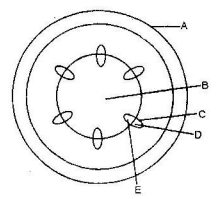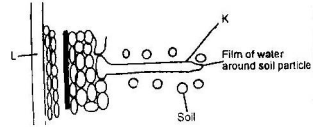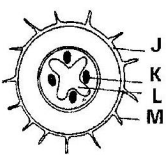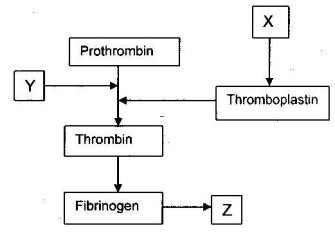Transport in Plants - Questions
- In an experiment, a leafy shoot was set up in a photometer and kept in a dark room for 2 hours. The set up was then transferred to a well-lit room for 2 hours.
- What was the aim of this experiment? (1mk)
- Explain the results which would be expected in each of the two experiments conditions. (3mks)
- Explain how drooping of leaves on a hot sunny day is advantageous to plant. (2mks)
- Explain how environmental factors affect the rate of transpiration in flowering plants. (20mks)
- The diagram below represents a transverse section of a young stem.
- Name the parts labeled A and B (2mks)
A___________________
B____________________ - State the functions of the parts labeled C, D and E
C________________
D_______________
E_______________ - List three differences between the section shown above and one that would be obtained from the root of the same plant (3mks)
- Name the parts labeled A and B (2mks)
- The diagram below represents the pathway of water from soil into the plant.
- Name the structures labeled K and L
K_______________
L_______________ (2mks) - Explain how water from the soil reaches the structure labeled L. (5mks)
- Name the process by which mineral salts enter into the plant. (1mk)
- Name the structures labeled K and L
- State two ways in which xylem are adapted to their function. (2mks)
- What makes young herbaceous plant remain upright? (2mks)
- The diagram below represents part of phloem tissue
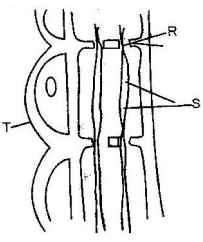
- Name the structures labeled R and S and a cell labeled T.
R ___________________
S ___________________
Cell T ___________________ (3mks) - State the function of the structure labeled S. (1mk)
- Explain why xylem is a mechanical tissue (2mks)
- Name the structures labeled R and S and a cell labeled T.
- Name the
- Material that strengthens xylem tissue. (1mk)
- Tissue that is removed when the bark of a dicotyledonous plant is ringed. (1mk)
- How are xylem vessels adapted for support? (1mk)
- What is the role of vascular bundles in plant nutrition? (3mks)
- Name two tissues which are thickened with lignin. (2mks)
- How is support attained in herbaceous plant? (1mk)
- The diagram below represents a transverse section through a plant organ.
- From which plant organ was the section obtained? (1mk)
- Give two reasons for your answer in (a) above. (2mks)
- Name the parts labeled J, K and L (3mks)
J__________________________________
K_________________________________
L_________________________________ - State two functions of the part labeled M. (2mks)
- Describe how water moves from the soil to the leaves in a tree. (20mks)
- State two ways in which the root hairs are adapted to their function. (2mks)
- The diagram below represents a plant tissue.
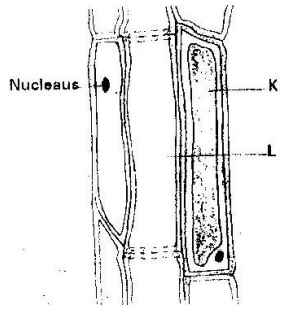
Name the parts labelled K and L.
K_________
L____________ - In an experiment to determine the effect of ringing on the concentration of sugar in phloem, a ring of bark from the stem of a tree was cut and removed. The amount of sugar in grammes per 16cm3 piece of bark above the ring was measured over a 24 hour period. Sugar was also measure in the bark of a similar stem of a tree which was not ringed. The results are shown in the table below
Time of the day Amount of sugar in grammes per 16 cm3 piece of bark Normal stem Ringed stem 0645 0.78 0.78 0945 0.80 0.91 1245 0.81 1.01 1545 0.80 1.04 1845 0.77 1.00 2145 0.73 0.95 0045 0.65 0.88 - Using the same axes, plot a graph of the amount of sugar against time (6mks)
- At what time was the amount of sugar highest in the;
- Ringed stem (1mk)
- Normal stem (1mk)
- How much sugar would be in the rigged stem if it was measured at 0345 hours. (2mks)
- Give reasons why there was sugar in the stems of both trees at 06 45 hours. (2mks)
- Account for the shape of the graph for the tree with ringed stem between:
- 0645 hours and 1545 hours (3mks)
- 1545 hours and 0045 hours (2mks)
- Other than sugars name two compounds that are translocated in phloem. (2mks)
- Explain why plants shed off their leaves. (2mks)
- What is the importance of transpiration to plants?
- Give adaptive features which enable a plant to reduce the loss of water.
Transport in Animals - Questions
- People can die when they inhale gases from burning charcoal in poorly ventilated rooms. What compound is formed in the human body that leads to such deaths? (1mk)
- Explain why blood from a donor whose blood group is A cannot be transfused into a recipient whose blood group is B. (2mks)
- State one difference between closed and open circulatory systems. (1mk)
-
- Give an example of a phylum where all members have
- Open circulatory system
- Closed circulatory system (2mks)
- What are the advantages of the closed circulatory system over the open circulatory system? (5mks)
- Give an example of a phylum where all members have
- Explain two ways in which mammalian erythrocytes (red blood cells) are adapted to their function (2mks)
- Name the blood vessels that link arterioles with venules. (1mk)
- Explain four ways in which the vessels you named in (a) above are suited to carrying out their functions. (4mks)
- State two ways in which the composition of blood in the pulmonary arterioles differ from that in the pulmonary venules. (2mks)
- Why would carboxyhaemoglobin lead to death? (2mks)
- Explain how the red blood cells of mammals are adapted for efficient transport of oxygen. (2mks)
- The chart below is a summary of the blood clotting mechanism in man.
Name- The blood cells represented by X
- Metal ion represented by Y
- The end product of the mechanism represented Z
-
- How can excess bleeding result in death? (2mks)
- Name the process by which the human body naturally stops bleeding. (1mk)
- How can low blood volume be brought back to normal? (2mks)
-
- Name one defect of the circulatory system in humans. (1mk)
- State three functions of blood other than transport. (3mks)
-
- What prevents blood in veins from flowing backwards? (1mk)
- State two ways in which the red blood cells are adapted to their function. (2mks)
- State one way by which HIV/AIDS is transmitted from mother to child. (1mk)
- Explain how the various components of blood are adapted for their function. (20mks)
- Distinguish between blood, plasma, serum, tissue fluid and lymph. (10mks)
-
- A patient whose blood group is A died shortly after receiving blood from a person of blood group B. Explain the possible cause of death of the patient. (2mks)
- A person of blood group AB requires a transfusion.
- Name the blood groups of the possible donors (2mks)
- Give reasons for your answer in (i) above. (2mks)
- Differentiate between active immunity and passive immunity. (2mks)
- Explain why a person can catch a cold several times in a year but only catches measles once in his or her lifetime. (2mks)
- Most carbon dioxide is transported from tissues to the lungs within the red blood cells and not in the blood plasma. Give two advantages of this mode of transport. (2mks)
- What is the importance of tissue fluid? (2mks)
Answers - Transport in Plants
-
- To investigate the effect of light on the rate of transpiration.
- More water was lost in the light than in the dark. Rate of transpiration was greater in light than in the dark. This is because the stomata are fully open in light but less open or closed in the dark. In light, photosynthesis takes place hence no water used.
- The leaves exposed a smaller surface area to the sun thus reducing transpiration/Excessive water loss.
-
- Temperature- high temperature increase transportation. Low temperature lower transpiration.
- Light intensity-more light increase transpiration, dim light lower transpiration.
- Wind – strong wind increase transpiration, calm weather lower transpiration.
- Humidity – High humidity lower transpiration, low humidity increase transpiration.
- Atmospheric pressure- High atmospheric pressure increase transpiration.
- Water availability-more water increase transpiration due to opening of stomata while little water lowers transpiration.
-
- A - Epidermis
B - Pith - C - Transport manufactured food/translocation
D - Produce new cells/divide giving new cells
E - Transport mineral salts and water. - -Xylem in centre/star shaped.
-Phloem in arm of xylem
-No pith in root
-Roots hairs present in root
- A - Epidermis
-
- K - Root hair
L - Xylem vessel - Water moves from the soil into the root hair by osmosis. Because concentration of cell sap is higher than water in the soil; the cell sap of the root hair is diluted thus making it less concentrated than neighbouring cells; therefore water moves into the neighbouring cell. It is then actively secreted into L.
- Active transport/diffusion.
- K - Root hair
-
- Lignified/thickened to prevent collapsing.
- Narrow to facilitate capillarity
- No cross wall for continuous flow of water.
- Side walls pitted to allow lateral movement of water and mineral salts.
-
- Turgidity
- Presence of xylem vessels
- Presence of collenchyma
-
- R- sieve pore/plate
S-Cytoplasm strand
T- Companion cell - Translocation
- Thickened, - Lignified
- R- sieve pore/plate
-
- Lignin,
- Phloem
- They are strengthened by lignin hence supporting the stem.
- - Xylem - Transports water and mineral salts to photosynthesizing cells
- Phloem - Transports manufactured foods from the leaves creating high concentration gradient.
- Veins - Supports the leaf to be upright for maximum absorption of light for photosynthesis. -
- -Xylem vessels
-Sclerenchyma - -Turgidity of parenchyma cells
-Presence of collenchyma cells
- -Xylem vessels
-
- Dicot root
- Presence of root hairs
- Phloem between rays of xylem (star shaped xylem).
- J - Epidermis
K - Phloem
L - Xylem - Absorbs water and mineral salts from soil.
- - Adhesion- force of attraction between unlike molecules
- Due to the force of adhesion water tends to stick to the walls of vessels containing it.
- Cohesion- forces of attraction between like molecules
- Cohesion between water molecules prevents the water column from breaking.
- Root pressure- due to pressure generated by the root’s endodermis
- Capillary due to narrowness of xylem.
- Transpiration pull- as water evaporates from the leaf’s surface more is absorbed
- After the water reaches the leaves cells, it passes the cells by osmosis from the xylem. Water vapour diffuses out through stomata. - - Absence of cuticle to allow diffusion of water.
- Thin walled to reduce distance of diffusion.
- Elongated to increase surface area for absorption of water and mineral salts.
- Presence of large vacuole to increase concentration gradient between cell sap and soil water. -
- Phloem tissues
- K- Companion cell
- Supply nutrients and energy to the sieve tubes.
-
- Graph
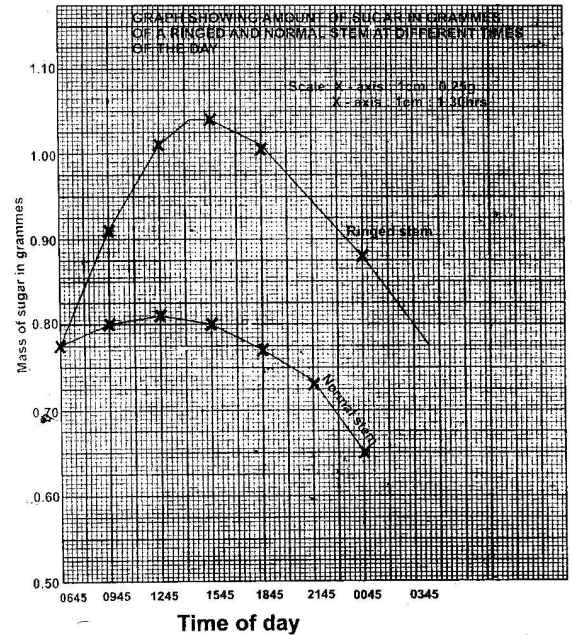
-
- 15:45
- 12:45
- 0.79 ± 0.02 grammes
- The food that had been manufactured the previous day had been converted to soluble sugars and was being translocated to other parts of the plant.
-
- 0645 hours and 1545 hours.
- There was low concentration of sugar early in the morning as there was little translocation.
- As day progresses the light intensity increases and more food is manufactured thus more translocation increasing concentration of sugars. - 1545 and 0045
- The light intensity is decreasing reducing rate of photosynthesis. Less food is manufactured, hence less is translocated.
- As it turns dark there is no photosynthesis reducing concentration of sugar translocated. - Sieve plates
- Cytoplasmic strands
- 0645 hours and 1545 hours.
- - Amino acids
- Soluble fats/lipids.
- Graph
-
- Reduce transpiration
- Eliminate excretory wastes on the leaf
-
- - Maintain transpiration stream
- Cool the plant
- Remove excess water
- Enhance absorption and distribution of water and mineral salts. - - Few and small leaves
- Reduced leaf size
- Sunken stomata
- Thick cuticle.
- - Maintain transpiration stream
Answers - Transport in Animals
- Carboxyhaemoglobin
- Blood group A has antigens A on red blood cells and antibodies b in plasma.
Recipient’s blood group B has B antigens and a antibodies. When blood group A from donor is transferred antigen A will react with antibody a in the recipient’s blood. Clumping or agglutination of the red blood cells will take place: the clumped red blood cells block capillaries and this hinders the flow of blood and may result in death. - In a closed circulatory system, blood flow is confined to enclosed vessels while in open circulation blood is not confined to vessels but flows in cavities (sinuses) and is in direct contact with tissues.
-
-
- Arthropoda
- Chordata
- When blood is confined within vessels, it generates high pressure. This results in a faster rate of circulation, over long distances, ensuring efficient transportation of material e.g nutrient to all parts of the body, which renders the animals more active than those with open circulatory system.
-
-
- They contain haemoglobin, a molecule that readily combine with oxygen.
- They are biconcave discs without a nucleus, allowing more haemoglobin to be packed in cells so that each cell can carry more oxygen.
-
-
- - Capillaries
- - They are thin-walled (one cell thick), thus allowing diffusion of materials.
- - Have a small diameter to increase pressure thus allow materials to diffuse out.
- They are intimately associated with tissues in order to allow exchange of materials
- They are numerous- to provide a large surface area for exchange of materials. -
- Pulmonary arterioles contain more carbon dioxide than pulmonary venules.
- Pulmonary arterioles contain less oxygen than pulmonary venules.
-
- It does not dissociate easily hence leads to suffocation
-
- They contain haemoglobin, a molecule that readily combine with oxygen.
- They are biconcave discs without a nucleus, allowing more haemoglobin to be packed in cells so that each cell can carry more oxygen.
-
- Platelets (Thrombocytes)
- Calcium, Ca2+
- Fibrin.
-
- Anemia/low blood volume/low haemoglobin leading to low oxygen, loss of nutrients and dehydration.
- Blood clotting
- Transfusion, taking fluids/eating iron in foodstuff/taking iron tablets.
-
- - Thrombosis
- Arteriosclerosis
- Varicose veins - - Regulate body temperature
- Regulate pH of fluids
- Regulate osmotic pressure
- - Thrombosis
-
- Presence of valves
- - Have biconcave shape to increase surface area for absorption of gases.
- Absence of nucleus and other organelles
- To increase packaging of haemoglobin.
- Presence of red pigment haemoglobin that has high affinity for oxygen.
- - During birth
- Breast feeding - - Red blood cells have a biconcave shape, which increases the surface area for gaseous exchange. They have a thin plasma membrane, which allows rapid diffusion of gases. They contain haemoglobin, which readily combines with oxygen in areas of high oxygen tension (lungs) and releases it readily in areas of low oxygen tension (other body tissues).
- They have no organelles with whole internal space being filled with haemoglobin. They contain the enzyme carbonic anhydrase which help in the transport of carbon dioxide.
- Some white blood cells are phagocytic which enables them to engulf and destroy invading micro-organisms. They are also capable of amoeboid motion, which enables them to squeeze between cells of the capillary wall and into infected tissues where they proceed to engulf invading micro organisms other white blood cells called lymphocytes are able to recognize antigens of invading micro-organism and to form antibodies against them.
- Platelets are able to aggregate at the site of a damaged blood vessel forming a temporary platelet plug which stops blood loss. They also produce the substance called thromboplastin which initiates the blood clotting mechanism.
- Plasma is composed mainly of water which is a solvent for a large variety of substance. This enables it to act as a medium for transport of a large number of water soluble substances. It has a high heat capacity that enables it to transport heat from highly active tissues to the rest of the body. - Blood: Tissues which consist of a liquid part called plasma in which several types of cells are suspended.
Plasma: Liquid part of the blood
Serum: Plasma from which the blood clotting protein called fibrinogen has been removed. It does not clot.
Tissue fluid: Liquid part of blood without plasma proteins. It is derived from the blood by the process of ultra filtration.
Lymph: is a tissue fluid, which drains into lymphatic vessels instead of going back into the blood vessels. -
- The patient’s red blood cells have antigen A on their membrane and his plasma has anti-b antibodies .
The donor’s red blood cells have antigen B on their membrane and his plasma has anti-a antibodies. After transfusion, the anti-b antibodies in the patient’s plasma reacted with B antigens on the donor’s red blood cell membrane. This led to clumping together of the donor red blood cells a process called haemagglutination. This may have caused blockage of capillaries in a vital organ like the heart or brain leading to death. -
- A,B,AB,O
- He is universal recipient. His plasma’ lacks antibodies.
- The patient’s red blood cells have antigen A on their membrane and his plasma has anti-b antibodies .
- Active immunity - that is produced when an animal’s body reacts to an antigen by producing antibodies.
Passive immunity - Immunity that is produced when antibodies are transferred from one individual to another. - Antibodies formed against common cold viruses remain in the body and provide immunity for only a few days. Therefore, once a person has recovered from cold, he/she is only protected for a few days. Those antibodies formed against measles virus remain in the body and provide immunity throughout the person’s life.
Therefore, once a person has recovered from measles, he or she is protected for life. - PH of blood plasma is not altered homeostasis is maintained. Within the red blood cells, there is an enzyme (carbonic anhydrate) which help in fast loading/combination and offloading/dissociation of carbon dioxide.
- Through tissues fluid, Oxygen and other food substance pass from the blood to the cells. Carbon dioxide waste substance passes from the cells to the blood through it.
Join our whatsapp group for latest updates
Tap Here to Download for 50/-
Get on WhatsApp for 50/-
Download Transport in Plants and Animals Questions and Answers - Biology Form 2 Topical Revision.
Tap Here to Download for 50/-
Get on WhatsApp for 50/-
Why download?
- ✔ To read offline at any time.
- ✔ To Print at your convenience
- ✔ Share Easily with Friends / Students

